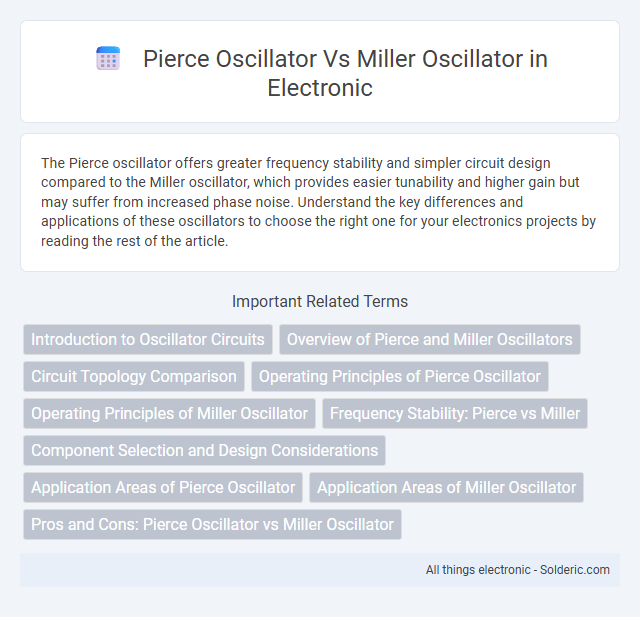The Pierce oscillator offers greater frequency stability and simpler circuit design compared to the Miller oscillator, which provides easier tunability and higher gain but may suffer from increased phase noise. Understand the key differences and applications of these oscillators to choose the right one for your electronics projects by reading the rest of the article.
Comparison Table
| Feature | Pierce Oscillator | Miller Oscillator |
|---|---|---|
| Oscillation Principle | Crystal-controlled feedback with inverter stage | Feedback via capacitive Miller effect amplification |
| Frequency Stability | High, due to crystal resonance | Moderate, depends on component values |
| Applications | Precise clocks, microcontrollers, RF circuits | Low-frequency signal generation, audio oscillators |
| Complexity | Simple circuit with fewer components | More components, complex tuning |
| Component Sensitivity | Less sensitive to component variations | Highly sensitive to capacitor and resistor changes |
| Output Waveform | Stable sine wave | Distorted sine or square wave |
| Power Consumption | Low to moderate | Moderate to high |
Introduction to Oscillator Circuits
Oscillator circuits generate continuous wave signals essential for communication systems, with Pierce and Miller oscillators being common types. The Pierce oscillator uses a crystal and inverter to achieve stable, high-frequency oscillations ideal for precise timing applications. The Miller oscillator relies on an amplifier and capacitive feedback, offering simplicity and flexibility but generally less frequency stability compared to the Pierce design.
Overview of Pierce and Miller Oscillators
The Pierce oscillator utilizes a crystal and a single transistor or inverter to generate a stable frequency with low phase noise, making it ideal for precision timing applications. The Miller oscillator employs a feedback capacitor and resistor network to produce oscillations, often used in integrated circuit designs due to its simplicity and ease of integration. Both oscillators serve distinct roles in electronic circuits, with the Pierce oscillator favored for crystal-controlled stability and the Miller oscillator for variable frequency generation.
Circuit Topology Comparison
The Pierce oscillator features a simple feedback loop using a single inverter with a quartz crystal connected between the input and output, making it highly stable and ideal for clock generation in digital circuits. In contrast, the Miller oscillator relies on an amplifier with a Miller capacitance feedback network, offering adjustable frequency through capacitive components but generally exhibiting less frequency stability than the Pierce design. Understanding these circuit topologies helps you select the appropriate oscillator based on the balance between stability and frequency tuning requirements.
Operating Principles of Pierce Oscillator
The Pierce oscillator operates using a quartz crystal that stabilizes the frequency by exploiting the crystal's high Q factor and piezoelectric properties, creating a precise and stable oscillation. It typically employs a single transistor amplifier with a capacitive feedback network, where the crystal provides a frequency-selective path, ensuring minimal signal distortion. Understanding this principle helps you choose the Pierce oscillator for applications requiring low phase noise and long-term frequency stability.
Operating Principles of Miller Oscillator
The Miller oscillator operates by utilizing a single transistor amplifier combined with a feedback capacitor that introduces a phase shift of 180 degrees, forming a positive feedback loop essential for sustained oscillations. Its frequency of oscillation is primarily determined by the external RC network, which controls the phase and amplitude conditions for oscillation. This configuration allows the Miller oscillator to achieve stable frequency outputs with relatively simple circuitry, making it suitable for low-frequency signal generation.
Frequency Stability: Pierce vs Miller
Pierce oscillators offer superior frequency stability due to their reliance on quartz crystals, which provide a precise resonant frequency less affected by temperature and component variations. In contrast, Miller oscillators use RC networks or inductors, making their frequency more susceptible to drift from environmental changes or component tolerances. Your choice of oscillator depends on the required stability, with Pierce circuits preferred for applications demanding precise and stable frequency generation.
Component Selection and Design Considerations
Pierce oscillators primarily use a quartz crystal to ensure frequency stability with minimal component count, making the selection of the crystal and the load capacitors critical for accurate oscillation. In contrast, Miller oscillators rely on an RC network, where choosing resistors and capacitors involves balancing phase shift and gain to sustain oscillation, offering flexibility but less precision compared to crystal-based designs. Your design considerations should focus on the desired frequency stability and tuning range to determine whether the Pierce's precise crystal control or the Miller's adjustable components best suit your application.
Application Areas of Pierce Oscillator
Pierce oscillators are widely used in quartz crystal oscillator circuits for generating stable and precise clock signals in microcontrollers, watches, and communication devices. Their simple design and high frequency stability make them ideal for timing applications in embedded systems, RF communication, and digital electronics. You can rely on Pierce oscillators where accurate frequency generation and low phase noise are critical.
Application Areas of Miller Oscillator
Miller oscillators are prominently used in radio frequency applications and integrated circuits due to their ability to provide stable sine wave outputs at high frequencies. Their low power consumption and simplicity make them ideal for use in voltage-controlled oscillators (VCOs) and phase-locked loops (PLLs) within communication systems. The oscillator's design supports frequency synthesis in RF transmitters and receivers, enhancing modulation and demodulation processes.
Pros and Cons: Pierce Oscillator vs Miller Oscillator
The Pierce oscillator offers high frequency stability and low phase noise due to its simple design with a crystal and inverter, making it ideal for precise timing applications, but it can be sensitive to load capacitance variations. The Miller oscillator boasts ease of tuning and wider frequency range by using an RC network and active devices but suffers from higher phase noise and less frequency stability compared to crystal-based Pierce designs. While Pierce oscillators are preferred in high-precision environments, Miller oscillators are commonly used in simpler or variable frequency circuits where flexibility outweighs stringent stability demands.
Pierce oscillator vs Miller oscillator Infographic

 solderic.com
solderic.com